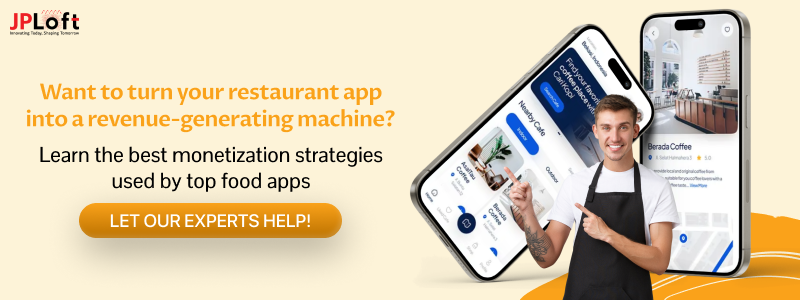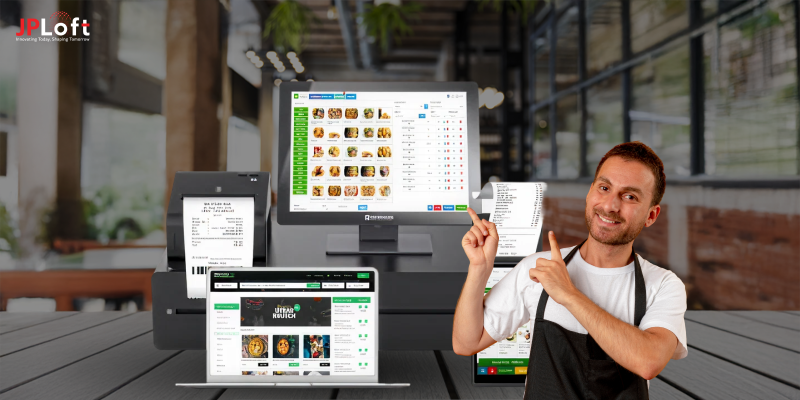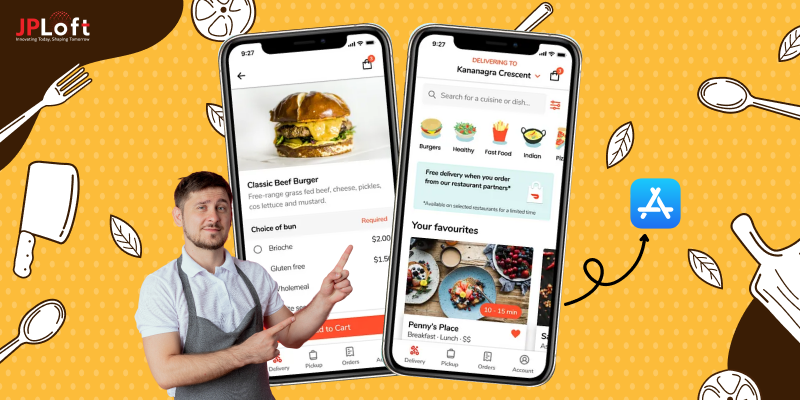Restaurant apps have completely transformed the dining experience. Ordering food, reserving tables, and browsing menus is now more convenient than ever before.
But have you ever wondered what lies behind this seamless user experience? How do restaurant apps make money? You must have thought about it after seeing the massive revenue of popular platforms like Uber Eats, DoorDash, and Grubhub.
Many of these top restaurant apps use a variety of monetization models to generate income—each tailored to their services and audience.
From delivery charges and commissions to ads, premium listings, and even subscription models, there are multiple revenue streams app owners can tap into.
If you’re a startup or entrepreneur thinking of entering this space, this blog is for you.
We’ll explore how today’s leading restaurant apps make money, dive into their monetization models, and help you understand how to choose the right one for your business.
Restaurant App Industry Growth Potential: Key Statistics
The restaurant app industry is growing rapidly, driven by convenience and changing consumer habits.
-
- As of 2024, the global restaurant management software market which powers most restaurant apps was valued at approximately USD 5.79 billion.
- This market is projected to reach USD 14.7 billion by 2030, growing at a CAGR of 17.4%, reflecting increasing adoption of mobile-first tools like in-app ordering, digital menus, and reservation systems.
- Studies show that 60% of customers prefer using mobile apps to place food orders over other methods. Additionally, restaurant apps with loyalty programs see up to 30% higher customer retention.
- With rising smartphone penetration and demand for personalized experiences, the industry is expected to grow at a 10–12% CAGR in the next few years, making app-based monetization more important than ever.
- About 63% of restaurants worldwide have adopted some form of mobile app or web-based platform for reservations, orders, or guest engagement.
Now’s the perfect time to invest in building your own restaurant app.
With market demand rising and mobile-first experiences becoming the norm, the opportunity is wide open.
Not sure where to begin? Check out our best restaurant app idea to help you get started with a winning concept.
Why Monetize a Restaurant App?
Monetizing a restaurant app is crucial if you want to turn your idea into a valuable business asset.
Since your restaurant app is not just a tool for taking orders, it's an asset that generates consistent revenue, enhances customer loyalty, and fuels long-term growth.
If you also want to turn your restaurant app into a long-term success. Here are the key reasons you must consider restaurant app monetization strategies in 2025.
1. Sustainable Revenue Generation
If you monetize your restaurant app, it can become more than just a utility- a revenue stream.
The introduction of the best monetization strategies for restaurant apps like premium listings, delivery charges and subscription plans for loyal customers, will help your app create consistent income beyond food sales.
This steady revenue will not only support your restaurant app business growth but also cover its operational costs.
2. Funds for Continuous Improvement
Continuous improvement is key if you want to keep up with user expectations and changing tech trends without cutting into your core restaurant app business' profits.
However, regular updates, UI enhancements, and feature upgrades require significant resources.
In addition, the ongoing app development process and customer support demand a steady flow of funds- this is where restaurant app monetization models come in to fund the required improvements.
3. Stronger Customer Retention
Monetization isn't just charging money; it also helps you retain customers for a long time.
By simply implementing a restaurant app monetization strategy you can include loyalty programs, exclusive deals or early access features for the customers.
This will help keep them coming back and increase the lifetime value of your application.
That's how rewarding repeat customers with benefits will not only make them feel valued but also keep them within your app ecosystem.
4. Operational Efficiency & Automation
With the best monetization strategies for restaurant apps, platform owners can generate funds in abundance.
Using this, they can develop AI chatbots, smart order routing, table booking systems, and more to drive operational efficiency and automation.
To implement these features seamlessly, hire dedicated developers who can build and optimize solutions tailored to their specific workflows.
These advancements will eventually reduce manual workload, minimize errors, and speed up service—leading to better customer experiences and significant operational savings.
5. Data-Driven Growth
Among other reasons, restaurant tech startup monetization lets you collect and analyze user data more effectively.
You can simply track customers and get to know what they are willing to pay.
In fact, you gain insights into preferences, pricing sensitivity, and behaviour patterns, resulting in the development of smarter business strategies.
6. Competitive Edge
In current times, many restaurants have apps, but only a few manage to monetize them smartly.
However, if you offer premium features or unique experiences through your app, you can truly set yourself apart from the competition.
This not only boosts customer engagement but also positions your brand as tech-forward and customer-focused.
And while creating a standout app sounds exciting, don’t forget to prepare for potential restaurant app development challenges, such as scalability, feature integration, or real-time performance—because solving them early gives you a serious competitive edge.
7. Investor & Franchise Appeal
A monetized app signals scalability and long-term potential.
If you’re planning to attract investors or expand via franchises, showing that your app contributes to business growth strengthens your case and adds credibility to your brand.
How Do Restaurant Apps Make Money?
After understanding the importance of monetizing a restaurant app, it's crucial to know revenue strategies for restaurant booking apps.
These strategies can only do wonders for you when it comes to revenue generation.
If you are looking to develop a restaurant app, you must consider the best monetization strategies for restaurant apps.
Industry leaders like Uber Eats, DoorDash, Zomato, and Swiggy are actively using them today. Now it's your turn. Let's dive in.
1] Delivery & Convenience Fees
Almost every top restaurant or food delivery app adds a small delivery or convenience fee, especially during peak hours, weekends, or small-value orders.
Customers may grumble about the charge, but they still pay—because the value of convenience outweighs the cost.
These fees are typically dynamic and can adjust based on location, time, or demand, offering flexible revenue opportunities.
It also creates a pricing buffer for handling logistics and delivery-related expenses more efficiently.
This approach is one of the most commonly used restaurant app monetization models because it's simple, scalable, and effective.
Why This Works: Customers are often willing to pay extra for speed and convenience, especially during busy hours. The app generates consistent revenue without altering food prices.
2] Commission on Orders
This is one of the most straightforward and lucrative revenue channels to make money from restaurant apps.
Every time a customer places an order, the platform charges the restaurant a commission, usually ranging from 15% to 30%.
This method scales beautifully the more orders your app processes, the more revenue it generates without depending directly on user payments.
Restaurants benefit from increased exposure, and you earn a slice of every transaction.
Why This Works: It's a performance-based model that ties your revenue directly to the app’s success in driving orders aligning your interests with partner restaurants.
3] In-App Advertisements & Sponsored Listings
Have you noticed how certain restaurants always appear on the homepage or top of the search results?
These businesses pay for sponsored placements and in-app ads to improve visibility and gain more orders.
Whether it's banner ads, search result boosting, or homepage listings—every space becomes a monetization opportunity.
This strategy is highly profitable, especially when your app garners high daily traffic. In fact, it’s one of the key restaurant apps[' money-making models, proving that visibility can be just as valuable as the food being delivered.
Why This Works: Restaurants compete for visibility. Your platform becomes a valuable billboard, earning ad revenue without affecting the user experience.
4] Subscription Models (Loyalty Plans)
These restaurant app monetization models can turn out to be a game-changer for your restaurant app.
Loyalty plans or monthly subscription packages offer premium benefits to customers—like free deliveries, exclusive discounts, and early access to offers.
Customers pay a fixed monthly or annual fee, and in return, enjoy an upgraded experience with consistent perks.
The subscription model for restaurants creates recurring income for your app and incentivizes users to stick around longer.
In fact, loyalty-based subscriptions are among the most effective restaurant app development trends in 2025, helping brands drive engagement and boost lifetime customer value.
Once subscribed, customers are more likely to order often to get the most value out of their plan.
Why This Works: It turns occasional users into long-term loyal customers while giving your business predictable monthly revenue.
5] Surge Pricing / Smart Delivery Charges
This restaurant mobile app revenue model increases delivery fees during peak demand periods—such as weekends, holidays, or bad weather.
Smart pricing helps maximize earnings when order volumes spike and delivery partners are in short supply.
It also acts as a tool to regulate demand and ensure that only high-value orders come through during rush hours.
Many platforms now use AI in restaurant apps to predict demand and auto-adjust fees.
Why This Works: It boosts revenue during high-traffic times and helps manage delivery logistics more efficiently by spreading out demand.
6] Exclusive Restaurant Partnerships
Some restaurant apps create exclusive deals with top-performing or unique restaurants.
In return for platform exclusivity, restaurants receive extra visibility and marketing support.
Customers, meanwhile, can only order from those restaurants through your app—driving more app installs and engagement.
These partnerships often involve higher commissions or flat promotional fees from the restaurants, making them one of the more strategic restaurant app revenue strategies used by leading platforms.
Why This Works: It builds brand exclusivity and user loyalty while locking in restaurants to premium, long-term partnerships.
7] Cloud Kitchens & Virtual Brands
These revenue streams for restaurant tech platforms are gaining popularity since cloud kitchens operate without dine-in facilities and serve only delivery orders through app platforms.
Your app can launch or partner with such virtual brands, reducing overhead costs like rent and staff.
With low operating expenses and full control over branding, these kitchens allow you to retain most of the profit margin.
Some apps even manage multiple cuisine-specific virtual brands under one kitchen.
Why This Works: It increases profitability with minimal setup costs while letting you tap into niche cuisines or experimental menus without risks.
8] Table Reservation & Event Booking Fees
Allow users to reserve tables in advance at premium restaurants or book passes for culinary events and food festivals.
Your platform earns a small commission per reservation or event ticket booked.
This adds an entirely new revenue stream that doesn’t depend on food delivery.
It also expands your app’s usefulness, especially for dine-in-centric users, and provides another example of how restaurant apps make money beyond the typical delivery model.
Why This Works: It monetizes restaurant footfall without any operational costs on your end—earning revenue from every booked experience.
9] Affiliate & Cross-Selling Opportunities
Your app can showcase third-party offers—like grocery bundles, kitchenware, or financial products—and earn a referral fee.
These partnerships are especially effective when embedded within user journeys (e.g., at checkout or post-order screens).
Used as a monetization strategy for restaurant app platforms, affiliate and cross-selling models allow you to tap into new income streams without disrupting the core experience.
Users benefit from curated, relevant offers, while your app earns passive income through affiliate links and brand partnerships.
These collaborations are often low-maintenance and can be scaled easily.
Why This Works: You earn additional revenue per referral without needing to create or manage the products yourself.
10] Merch & Gift Card Sales
Go beyond food by offering branded merchandise, discount vouchers, or digital gift cards.
You can sell everything from quirky mugs to exclusive T-shirts and prepaid dining credits.
This model not only drives extra income but also strengthens your brand identity in a fun and viral way.
Customers love sending gift cards for birthdays, celebrations, and special offers—making it one of the key restaurant apps' money-making models that blends commerce with customer loyalty.
Why This Works: It opens up a retail stream that builds brand engagement while monetizing loyal customers in creative ways.
Famous Restaurant Apps and Their Monetization Models
Let’s take a look at some of the best restaurant apps in the game and how restaurant apps make money in today’s competitive market.
Each one has its own unique blend of monetization tactics—some traditional, others surprisingly creative—giving us a clearer picture of what actually works.
1. Uber Eats
Uber Eats is a global food delivery titan that started as UberFRESH in August 2014 and rebranded in 2015.
2025 snapshot: In Q1 2025, Uber overall reported 170 million monthly active users, and delivery bookings reached 20.38 billion, contributing to delivery revenues of around $11.5 billion.
Looking ahead: With gross bookings growing 14–18% YoY and planned expansion into new regions like Australia, Uber Eats is projected to continue growing at ~15% annually.
Monetization model:
-
- Delivery and convenience fees
- Commissions from restaurants (15–30%)
- Sponsored listings
- Subscription via "Eats Pass"
- Niches like “Dine‑Out” reservations
2. DoorDash
DoorDash is the leading U.S. food delivery platform (founded 2013). It commands around 55–60% of the U.S. market, and by 2025 the U.S. food delivery industry is set to hit $50 billion.
2025 data: Subscriptions via DashPass exceed 15 million, and the app generated billions in GMV from millions of monthly users.
DoorDash is a prime example of how effective restaurant app monetization models can drive massive growth and sustained revenue.
It monetizes through:
-
- Delivery/convenience fees
- Merchant commissions (around 20–30%)
- DashPass subscriptions
- In‑app advertising & sponsored placements
3. Grubhub
Grubhub, founded in 2004, is a pioneer in U.S. online food delivery. It holds about 10% of the U.S. market share as of 2025.
2025 snapshot: Within a $50B market, Grubhub continues steady growth thanks to its loyal user base, though it trails DoorDash and Uber Eats.
Monetization:
-
- Commissions and delivery fees
- Featured placements and in-app ads
- Optional subscription or loyalty perks
4. Resy
Resy is a restaurant reservation app launched in 2014 by Vaynerchuk, Leventhal & Montero, later acquired by American Express in 2019. It initially operated in the U.S. and then expanded globally.
Current footprint: As of 2023, it covers ~16,000 restaurants; earlier data (circa 2018) hinted at 2.7m users and 1m weekly bookings.
Revenue metrics: Annual revenues are estimated to be around $40 million in early 2025.
Resy stands out with its clever use of restaurant app revenue strategies, offering value to both diners and restaurant partners through a flexible business model.
Monetization model:
-
- Restaurant subscription fees
- “Hot” reservation premiums (dynamic pricing)
- Revenue share with restaurants
5. Yelp
Yelp is best known as a user-review platform, but it also includes:
-
- Reservations (via integrations with OpenTable/Resy)
- Delivery orders
- Sponsored listings
Founded way back in 2004, it's available globally. As of 2025, Yelp has 19 million monthly unique users, and advertising revenue alone was about $1.4 billion annually (majority from local businesses).
Monetization model:
-
- Local business advertising
- Sponsored placements
- Reservation fees via partner services
6. OpenTable
OpenTable, launched in 1998, is the original online reservation platform. It operates in 80+ countries with ~60,000 restaurants connected globally and over 1 billion reservations annually.
2025 data: Its parent company, Booking Holdings, reports annual revenues of roughly $1 billion, with OpenTable contributing a strong portion.
User base: Tens of millions of diners make reservations through the platform every month, making it a go-to choice for seamless dining experiences.
For those looking to create an app like OpenTable, understanding its monetization strategy is key to replicating its success.
Monetization model:
-
- Per-cover booking fee from restaurants
- Subscription plan for enhanced restaurant tools
- Premium restaurant analytics and marketing dashboards
7. Avero
Avero is a restaurant analytics and operations intelligence tool, founded in 2005, focusing on performance-driven data insights.
2025 market: Part of the $2–2.1 billion restaurant analytics market, forecasted to grow at ~12–15% CAGR through 2033.
Client base: Serves thousands of restaurants globally, mainly in North America, with multi-million annual recurring revenue (private estimates).
Avero’s approach to data-backed growth also reflects a robust restaurant app monetization strategy, proving that analytics platforms can be as profitable as consumer-facing apps.
Monetization model:
-
- SaaS subscriptions (tiered by restaurant size)
- Premium modules (demand forecasting, labor optimization)
- Integration and consulting fees
These apps have built unique revenue stacks—from booking fees and delivery charges to subscriptions, advertising, and analytics.
Whether it’s Uber Eats scaling through convenience fees, Resy charging premiums for “hot tables,” or Avero offering data-as-a-service tools—each model aligns closely with its value proposition.
If you're plotting your own restaurant app, borrowing and customizing elements from these proven paths is a smart start.
How to Choose the Right Monetization Model for Your Restaurant App?
Choosing the right monetization model for your restaurant app isn’t easy. Since it depends on several factors, such as your business goals, audience, and restaurant app features.
If you want to pick the best solution, you need to look for a balance between earning money and keeping your users happy. Here's how you can figure it out:
► Understand Your Audience First
You can start your journey to choosing the right monetization model just by simply asking, Who are your users?
If they’re price-sensitive users, it will be a bad idea to load your app with ads and fees that might push them away.
But if they value convenience and premium service, there are chances that they may be ready to pay for subscriptions or faster delivery.
So, before you decide how to charge them, first get to know their habits—because understanding your audience is the foundation of effective restaurant app monetization strategies in 2025.
► Evaluate Your Business Model
It is necessary to evaluate your restaurant delivery app business model. You can do so by finding out whether you are a single restaurant, a cloud kitchen, or a food delivery aggregator.
Accordingly, tailor your monetization to fit your size and structure. This is because a local café might benefit more from in-app loyalty programs and gift cards.
On the other hand, a larger marketplace platform might earn better through restaurant commissions and featured listings.
► Start Small with One or Two Revenue Streams
You don’t need to monetize everything from day one.
You can start with one or two simple models, like charging a small delivery fee or offering a subscription plan.
First, test how users respond, then slowly expand based on what works.
► Keep User Experience at the Center
Whatever model you choose, it should never ruin the user experience.
Too many ads, hidden charges, or paywalls can drive customers away.
That’s why even the most effective revenue strategies for restaurant booking apps need to be implemented thoughtfully.
Monetization should feel like added value—not a burden—for users who rely on your app for convenience and ease.
► Watch Your Competitors
Check out what other successful restaurant apps are doing.
Are they offering premium subscriptions? Running virtual kitchens? Or selling event tickets?
Learn from what’s working for them, and adapt it to your brand.
► Be Flexible and Open to Change
Your first monetization idea might not be the best one. That’s okay! Keep testing and tweaking.
You can always change things up as your app grows and your audience evolves.
Many successful restaurant app monetization models didn’t get it right the first time—they evolved through real user feedback and iteration.
In short, the right monetization model is the one that supports your growth without annoying your users.
Keep it smart, simple, and user-first, and you’ll find the sweet spot.
Why JPLoft is An Ideal Partner for Your Restaurant App Development?
Looking for a reliable tech partner to bring your restaurant app idea to life? As a leading restaurant app development company, JPLoft is here to serve exactly what your business needs.
With a strong track record in developing successful food delivery and restaurant apps, we combine smart technology with intuitive, user-friendly designs that keep your customers coming back for more.
At JPLoft, we understand that no two restaurants are the same.
Whether you need real-time order tracking, seamless online reservations, integrated payment systems, loyalty programs, or powerful monetization options, we customize every feature to align with your goals and audience expectations.
Our team of expert developers builds scalable, secure, and high-performance apps that not only look great but also deliver smooth experiences from kitchen to doorstep.
Let us help you develop a restaurant app that satisfies your customers, streamlines your operations, and boosts your business revenue.
Conclusion
Monetizing a restaurant app isn’t just about picking a revenue model—it’s about finding the right mix that drives income while keeping your users satisfied.
From delivery fees and commissions to subscriptions and cloud kitchens, today’s restaurant app monetization strategies in 2025 offer a wide range of options tailored to different business models and user expectations.
Long-term success depends on understanding your users, keeping an eye on what competitors are doing, and regularly improving your strategy to stay ahead.
Whether you're running a single outlet or a multi-city food delivery platform, the right strategy can transform your app from a simple service tool into a powerful and profitable business.
FAQs
Most apps combine multiple streams: they charge delivery/convenience fees, take a commission from restaurants, and sell in-app ads and sponsored listings. Additionally, they offer subscription plans and sometimes explore options like cloud kitchen, gift cards or even affiliate deals. It is the mix that makes it all work.
They primarily earn through a combination of delivery/convenience fees, restaurant commissions, subscriptions (like DashPass or Eats Pass), and in-app advertising. Some also explore cloud kitchens and exclusive partnerships for additional revenue.
Absolutely. Aggregator apps like Swiggy, Zomato, and Uber Eats typically charge a 15–30% commission per order. While big chains can negotiate lower rates, smaller eateries often operate on the standard slab and accept the trade-off for access to a wider customer base.
In-app ads and sponsored restaurant listings help apps earn additional income while helping restaurants and food brands get noticed. Restaurants pay for premium placement or higher visibility in search results.
JPLoft can help by building custom restaurant apps with smart, scalable monetization features like delivery charges, in-app ads, loyalty programs, and subscription models. We also offer expert guidance on choosing the right revenue strategy tailored to your business goals.













Share this blog